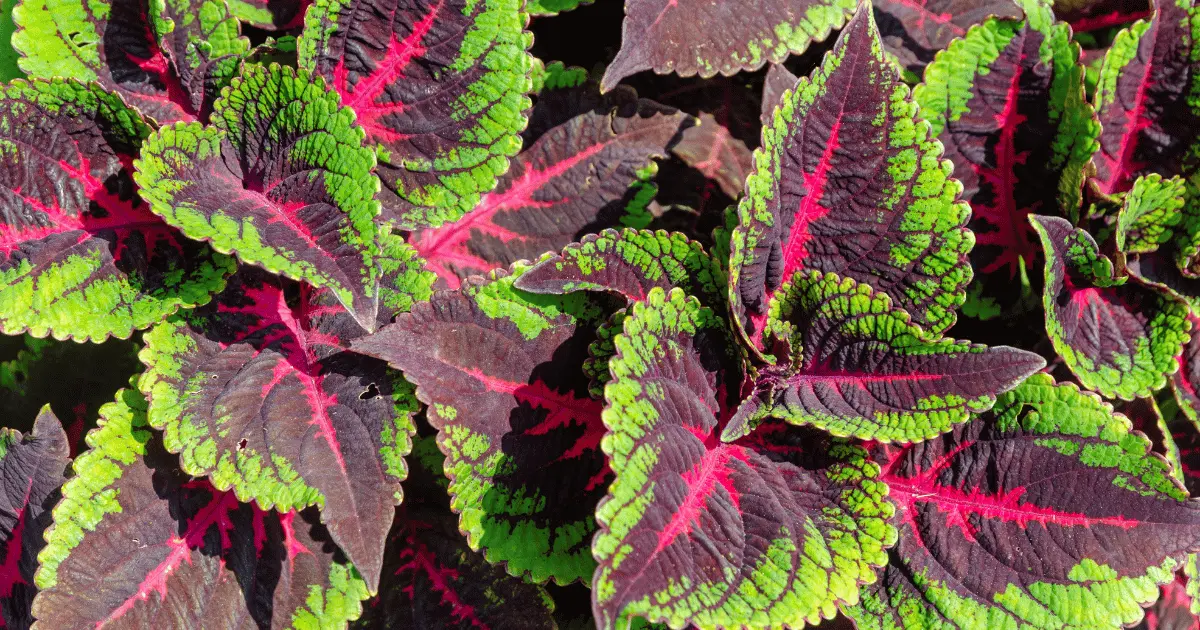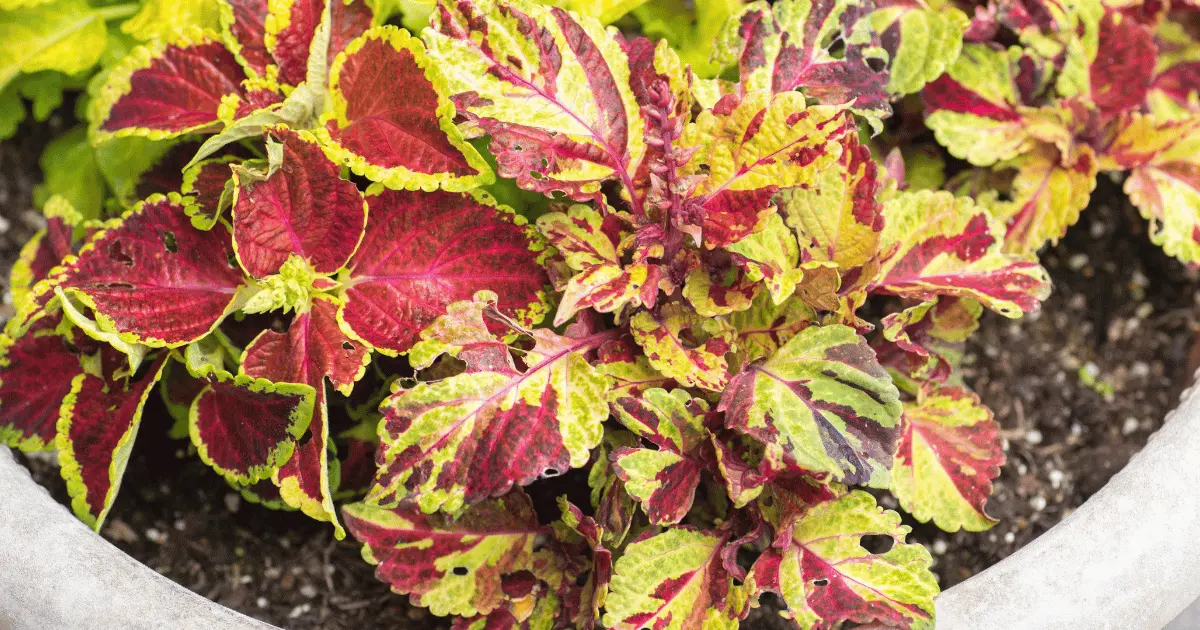Coleus plants comprise a broad diversity of widely propagated garden shrubs and herbaceous plants that bear luscious, plump, or thickened shoots and are originally native to tropical and subtropical climates.
Most Coleus varieties are commonly propagated as indoor and outdoor decorative garden plants ( especially Coleus scutellarioides, Coleus blumei, and Plectranthus scutellarioides) because of their radiantly pigmented love-shaped foliage, which appears in brilliant patterns and eye-catching outlines.
Propagating Coleus Plants

Coleus shrubs have a definite lifespan of only a year, as annuals, but with the right care, they can be grown as perennials, lasting as much as 4-5 years. They are highly adaptable, with flexible propagation needs; they can also be propagated in a pot or directly on the garden ground, making them an excellently versatile variety.
Stem cuttings commonly propagate coleus plants. The method is highly recommended because it is cost-effective and easy to carry out.
Stem Cuttings are taken from fully grown pots that look leggy or overgrown.
Each cutting should be 4-6 inches long, with each bearing up to two or three fully developed leaves. It’s best to make younger cuttings from stems closer to the bottom of the plant. Placing your cuttings on a dry plane surface for some hours until they’re completely healed prepares them for rooting.
Rooting your Coleus Cuttings in Water
Coleus stem cuttings are easily rooted in water; I prefer to apply this rooting method since it requires fewer materials to set up and allows me to monitor how the cuttings are doing in water closely.
To root them in water:
- Get a transparent glass jar or a gardening vase and pour some clean, untreated water to a depth of about 2-3 inches.
- Insert the cuttings into the vase and leave them slanting by the side.
- If your cuttings still have some leaves attached at the base, remove them before inserting them in water.
- Place the glass jar with the cuttings in it on a well-illuminated flat surface at an atmospheric temperature of 60°F – 75°F (16°C – 24°C) and change the water regularly as required; your cuttings will begin to root after 7-10 days, and you should transplant them immediately the roots are up to 1-inch long.
Rooting your Coleus Cuttings in a Potting Medium

Growing your cuttings in a potting soil mix offers some advantages over rooting in water: firstly, there’s no need to fear damaging the new roots during transplanting. Secondly, Coleus cuttings rooted in a soil mix potting tend to grow firmer roots with higher chances of success.
You must have gotten your soil mix ready; pour some of it into the pot and, using your tiny finger, make 1-inch deep holes inside the pot.
Dip your cuttings into a rooting hormone powder and insert them inside the holes in the pot. Rooting hormones help eliminate fungal and bacterial infections and speed up the time to root the cuttings.
Once the cuttings are planted, add more soil mix to the pot to make them stronger in their planted positions.
Now it’s time to water your pot; water thoroughly until the excess water begins to run off the draining holes. Next, place the pot on a cool, dry surface where it’ll receive up to 6 hours of indirect sunshine daily, and it will begin to root after 2-3 weeks.
Growing your young Coleus Pots
Coleus plants are generally considered shade-loving with fewer preservation needs, making them highly cost-effective to grow. While some early growing species like to bask in the full intensity of summer sunshine for hours, most are generally more conservative, preferring to remain under the protective shade.
With great attention, you’ll easily understand the peculiar light intensity your pots need. When the sun’s brilliance is excessive, their leaves appear burnt and discolored; growing them In a weakly illuminated position will also lead to stunted shoot development and smaller leaves that won’t be favorably pigmented.
For the more sensitive varieties, subjecting them to the diffused rays of early morning sunshine will do them a lot of good. They can be placed at angular positions that guarantee their colorful blooms are conspicuous such as along the front lawn, in the courtyard, around the verandah, or on a window sill.
They can remain outside for as long as summer lasts but shouldn’t be left to freeze outside during winter; they’re very gentle and easily get frost beaten during the cold winter nights.
Best Potting Medium for Growing Coleus
If you’re propagating them in a potting medium, ensure the pot is at most 8 inches in size. Coleus generally loves to space out and spread; although they don’t seem invasive, the plant should have enough room for ventilation. Growing them in smaller pots will adversely affect their development.
It’s best to grow them in a fast-draining well aerated, lightweight potting soil mix rich in organic content with a mildly acidic pH; any commercial orchid or cactus mix with good grit should be good enough. Adding perlite to your potting mix is ideal for boosting soil aeration.
I usually get a bigger pot of about 10-12 inches in diameter when I like to grow more bushy Coleus plants. The extra space will complement the additional plants in the same pot. One important way to ensure good drainage in the pot is to bore tiny draining holes around the sides and bottom of the pot.
Watering the Coleus Pots
Indoor pots don’t require as frequent watering as you would in the garden. During their active growing season between spring and summer, you should only water them if the topsoil of the potting medium appears dry to the touch.
The outdoor pots can be watered once or twice daily during the hot summer to protect their colorful leaves from dehydration. Coleus pots are tolerable to any watering technique and don’t mind the occasional misting or spraying of their shoots.
Bottom watering is a better option for indoor pots because the excess water flows out immediately, and there’s little chance of the leaves or roots getting rotting. It would be best if you watered them less frequently during winter.
It’s okay if their leaves appear somewhat discolored and begin to pluck off. This usually happens as they begin to get ready for their seasonal dormancy period. It would help if you only focused on keeping them safe and preserved from insect pests; therefore, only water them every fortnight during winter.
Coleus Plant Toxicity
Some varieties are mildly toxic to children and animals pets, mostly cats and dogs. When their oils and extracts are consumed, they can cause serious intestinal discomfort. Direct contact with the skin is also known to cause skin inflammations and a general imbalance in neuromuscular coordination.
Coleus varieties are not only propagated for their aesthetic appeal, as those that bear root tubers can also be grown for food, such as Coleus maculosus, Coleus rotundifolius, and Coleus esculentus.
It’s such a wonderful sight to see them bloom, but as much as you want them to bloom, blooming at the right time is key to achieving overall success with them. I find it particularly necessary to encourage them to keep growing once they bloom by nipping off the blooms, and that’s because more energy is directed to their flowering and seed production as they bloom.
Sometimes, it’s a good idea to nip off the delicate blooms in their early stages. Hence, the young Coleus continues to focus on its growth and development until it finally reaches maturity.
